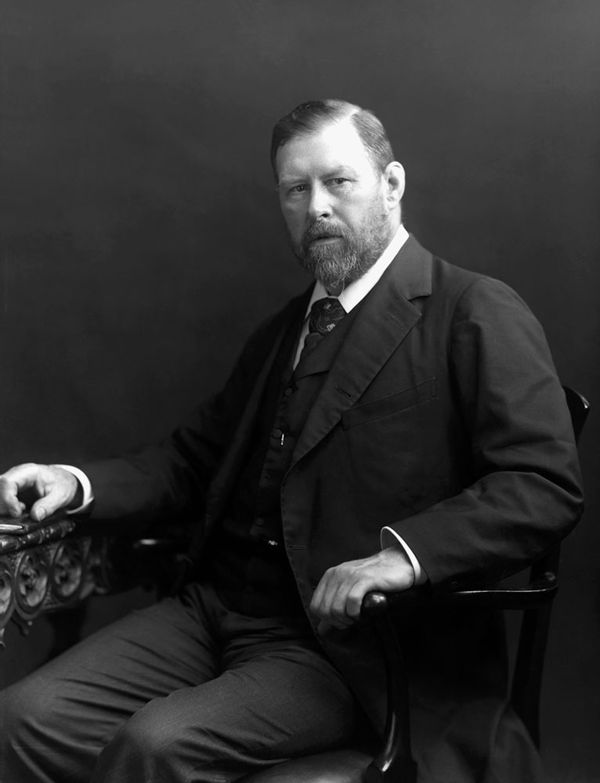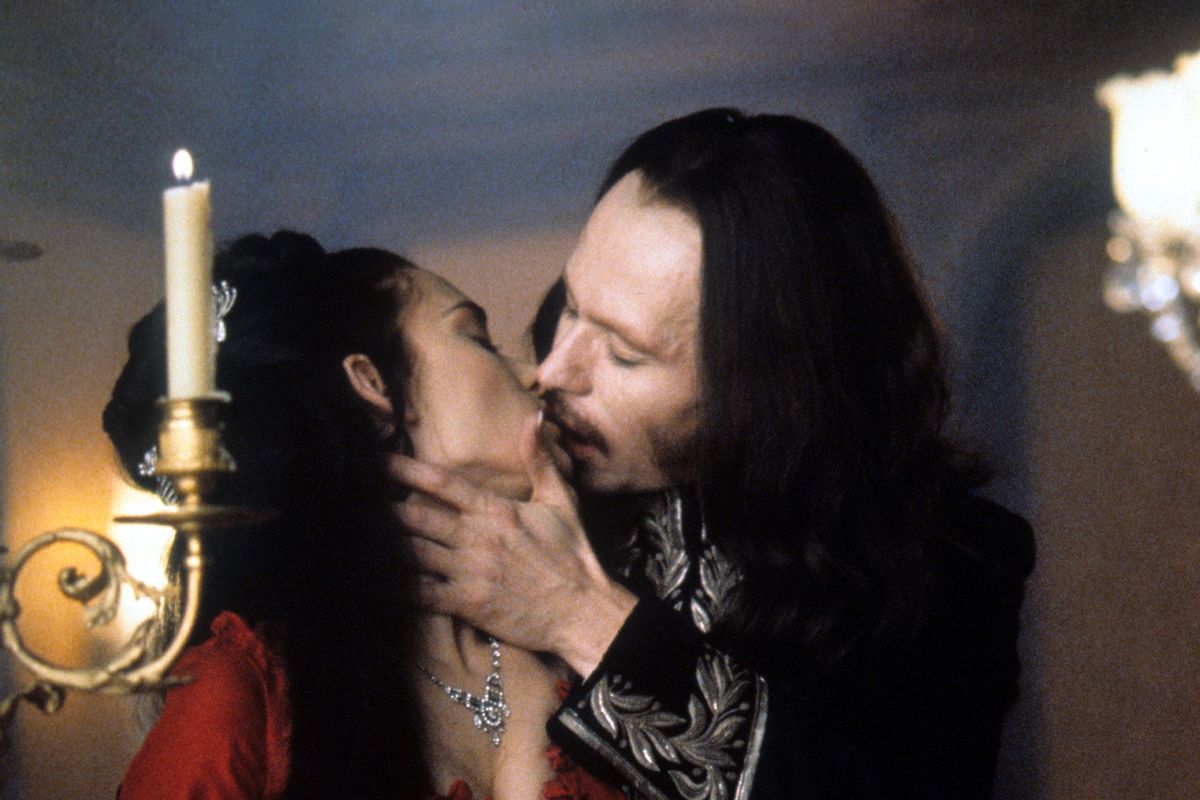This year marks the 125th anniversary of Bram Stoker's horror classic, "Dracula." Today the story, and more specifically the character, has conjured up hundreds of interpretations; Dracula himself is the second most popular character put to film, second only to Sherlock Holmes. There are the (relatively) faithful adaptations, the stage plays, the parodies, the barely recognizable CGI-action spectacles (I'm looking at you "Dracula Untold"), and the cameos. But few have embraced the queer side of the character, with its LGBTQ+ origins being traced back to the author himself.
While never as renowned a writer during his lifetime as many of his contemporaries, today Stoker is regarded as a literary titan for his thrilling imagination and his now-iconic characters. Even a titan of horror like Stoker has his own beginnings in writing. Prior to "Dracula," the Irish-born author embraced stories he related to the most.
Stoker himself was a closeted gay man who pined for affection from both his friends, mentors, and possible lovers Oscar Wilde and Walt Whitman.
His first book, "The Primrose Path," follows an Irishman who moves to London seeking better work, much as Stoker himself was swept up into the London scene pursuing work in the theater. His second book, "The Snake's Pass" becomes more fantastical, centering on the legend of Saint Patrick as he defeats the King of Snakes in Ireland. While both these books were quick endeavors for the author, they still exuded a quintessentially Stokerian Irish pride and sense of identity with hints of isolation.
Neither are particularly deep reads, and both were produced far quicker than his seven-year-long odyssey to write "Dracula." But it seems clear to me why it took so long for him to finish the bloody thing; it's brimming with controversy and self-reflection.
In reading "Dracula" ... one might be surprised or even confused with the frequency that sex and sexual imagery are discussed.
Stoker himself was a closeted gay man who pined for affection from both his friends, mentors, and possible lovers Oscar Wilde and Walt Whitman — men who both garnered controversy for their own depictions of homosexuality. Most obvious and scandalous of all are not the depictions of death, the supernatural, or the occult, but the frank detail surrounding sexuality and sexual orientation.
In reading "Dracula" (something I've done no less than half a dozen times in the past year), one might be surprised or even confused with the frequency that sex and sexual imagery are discussed. "Kiss" or "kisses" is used 42 times in the text, "lips" 62 with "voluptuous," often referring to the vampire's ruby red lips, coming up 12 times.
Jonathan Harker, when trapped in Dracula's castle and approached by a trio of vampires, remarks, "I felt in my heart a wicked, burning desire they would kiss me with those red lips" with one vampire laughing and saying, "There are kisses for us all." Only then does Dracula himself emerge, irate, proclaiming, "This man belongs to me!"
There are a myriad of themes here that echo throughout the rest of book. Domination and submission — played into and against gender stereotypes — polyamory and queer desires. Harker, on multiple occasions, takes notice in Dracula's lips and how they could kiss his neck. And this isn't even the wildest scene! Nearing the end of the book, Dracula breaks into the bedroom of the now married Harkers and . . . well . . . I'll let Stoker describe the scene.
On the bed beside the window lay Jonathan Harker, his face flushed and breathing heavily as though in a stupor. Kneeling on the near edge of the bed facing outward was the white-clad figure of his wife. By her side stood a tall, thin man, clad in black. His face was turned from us, but the instant we saw him we all recognised the Count — in every way, even to the scar on his forehead. With his left hand he held both Mrs. Harker's hands, keeping them away with her arms at full tension; his right hand gripped her by the back of the neck, forcing her face down on his bosom. Her white nightdress was smeared with blood, and a thin stream trickled down the man's bare breast which was shown by his torn-open dress. The attitude of the two had a terrible resemblance to a child forcing a kitten's nose into a saucer of milk to compel it to drink.
I think in "The New Annotated Dracula," Leslie S. Klinger put it best by writing, "What is going on here?" Leonard Wolf in "The Essential Dracula" writes that this extraordinary scene is "crammed with implications, nearly all of them sexual." You have "a vengeful cuckoldry . . . a ménage à trois . . . mutual oral sexuality . . . [and] the impregnation of Mina." Clive Leatherdale in "Dracula Unearthed" goes a step further to focus on the explicit reference of "milk" smeared on Mina's face to imply a bodily fluid that's not exactly blood.
 Bram Stoker (1847-1912) the Irish writer, best known for his novel Dracula (1897). (Hulton-Deutsch Collection/CORBIS/Corbis via Getty Images)
Bram Stoker (1847-1912) the Irish writer, best known for his novel Dracula (1897). (Hulton-Deutsch Collection/CORBIS/Corbis via Getty Images)
Of course, none of this would hold as much impact or relevance without the author's own complex relationship with desire. One of the prime written examples of Stoker's own sexual orientation is a lengthy, confessional "love letter" he sent to Walt Whitman, whose famous "Calamus" poems contained explicit homoerotic imagery and musings. The 24-year-old Stoker wrote, "I have to thank you for many happy hours, for I have read your poems with my door locked late at night and I have read them on the seashore where I could look all around me and see no more sign of human life than the ships out at sea: and here I often found myself waking up from a reverie with the book lying open before me."
Stoker goes on to lament his conservative upbringing and environment, thanking Whitman for his escapism and clarity in prose making the young man's "heart leap towards you across the Atlantic and his soul swelling at the words or rather the thoughts." Another curious inclusion appears to invert gender roles as Stoker writes of his own "woman's eyes" and professes to Whitman a hope to be "wife to his soul."
But Stoker's infatuation with men was not limited to just Whitman. There has been speculation about Stoker's boss, Sir Henry Irving, having his own influence in the iconography of "Dracula."
And then there is Oscar Wilde.
Stoker and Wilde attended university together and both men would make their way to London to pursue the arts. In 1895, Wilde was tried and convicted of violating Buggery Laws, at the peak of Stoker's writing of "Dracula." It upset Stoker that his friend and presumably a lover of his was sentenced to two years' imprisonment, but also terrifying that Wilde's own fictional writings were used as "evidence" against him in the trial. What must Stoker have thought of this while writing his own sexually charged tale? Is that fear not horror in and of itself?
But I haven't even mentioned the most Freudian fact of all! Bram Stoker married Florence Balcombe in 1878, after she had previously been engaged to one other man . . . Oscar Wilde. Of course, there is no shortage of complicated relationships depicted in "Dracula," either.
Want a daily wrap-up of all the news and commentary Salon has to offer? Subscribe to our morning newsletter, Crash Course.
For me, it doesn't require too deep a look at Stoker's own life to see that the horrors of "Dracula" do not all come from blood-sucking creatures. They can just as easily come from within, the anxieties, shock, and confusion associated with gender, sexual identity and orientation. It's a welcome change of pace that we have seen more recent vampiric works influenced by "Dracula" – such as the latest AMC adaptation of Anne Rice's "Interview with the Vampire" – showcase its queer origins, but more can be done. While "Interview" seems to show a willingness to depict this often forgotten aspect of the most pivotal vampiric creation, we need and should see this from the titular Count himself, as depicted not only in the original text itself, but from extrapolating information we know from Bram Stoker's own life. For this 125th anniversary, I say it's about time "Dracula" himself embraces his place in queer horror history.



Shares